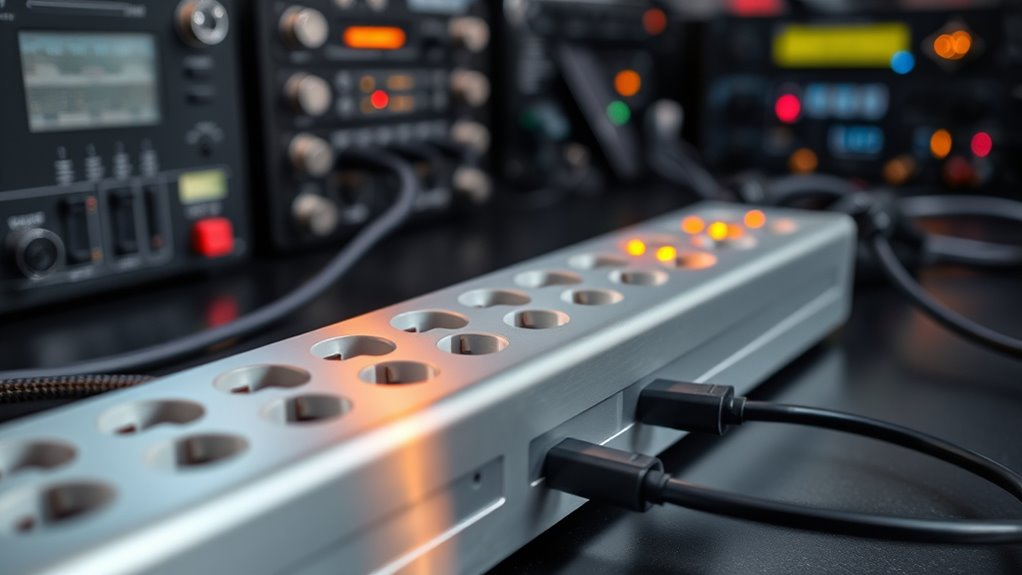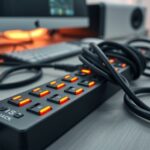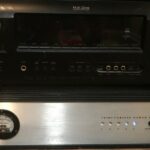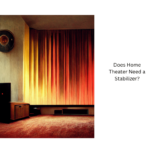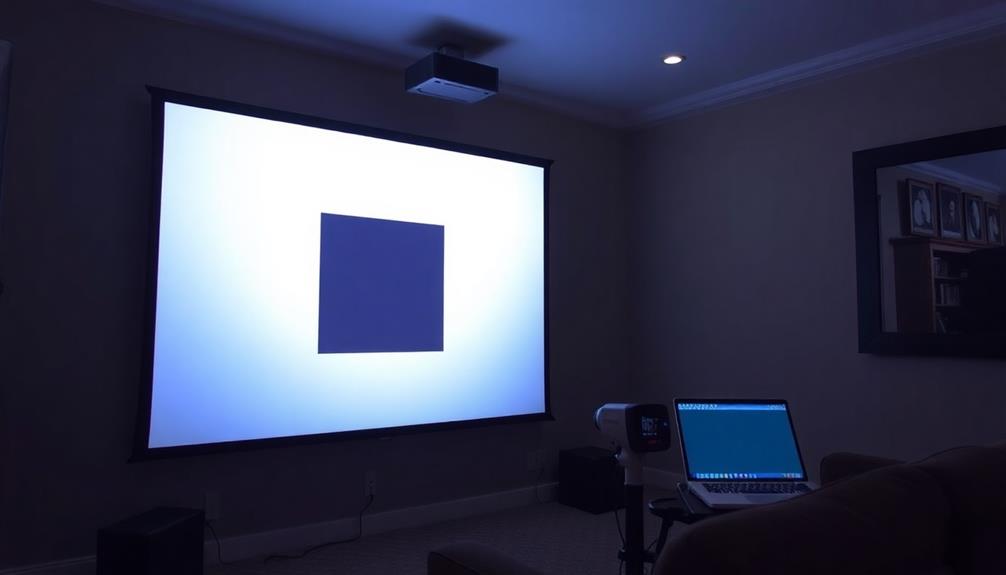To safeguard your gear, understand that surge protectors shield devices from voltage spikes caused by lightning or outages by diverting excess energy, but they wear out over time. Power conditioners go further, regulating voltage and filtering noise for more stable power flow, ideal for sensitive or high-end electronics. Choosing the right device depends on your equipment’s value and needs. Keep learning to ensure your gear stays safe and performs at its best.
Key Takeaways
- Surge protectors shield devices from voltage spikes by diverting excess energy, preventing damage during electrical surges.
- Power conditioners regulate voltage, filter noise, and provide stable power, ideal for sensitive or high-end equipment.
- Regular testing and timely replacement of surge protectors maintain effective protection as their components degrade over time.
- Choose surge protectors for basic needs and power conditioners for comprehensive, continuous protection of valuable electronics.
- Proper grounding and understanding device limitations enhance the effectiveness and lifespan of your electrical protection devices.
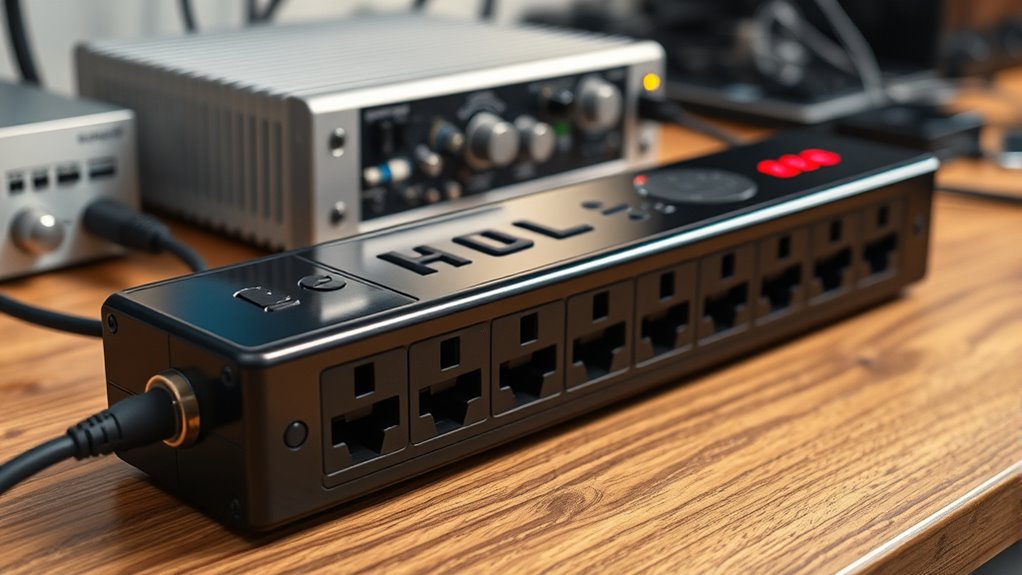
Protecting your electronics from power fluctuations is a crucial part of this process, and that’s where surge protectors and power conditioners come into play. Understanding the difference between these devices helps you choose the right solution for your needs, preventing damage and extending the lifespan of your gear.
Surge protectors are designed to shield your devices from sudden voltage spikes caused by lightning strikes, power outages, or other electrical disturbances. They work by diverting excess energy away from your equipment, typically through metal oxide varistors (MOVs) or similar components. When a surge occurs, the surge protector absorbs or redirects the excess voltage, preventing it from reaching your devices. This makes surge protectors a practical choice for everyday use, especially in areas prone to thunderstorms or unstable power supplies. However, keep in mind that surge protectors have a limited lifespan; their protective components degrade over time, especially after absorbing multiple surges. Once the protection wears out, the device no longer safeguards your equipment, so regular replacement or testing is essential. Regularly testing your surge protector’s effectiveness can help ensure ongoing protection. Additionally, considering the quality of your surge protector can influence its longevity and effectiveness. Moreover, understanding the cybersecurity vulnerabilities associated with connected devices underscores the importance of safeguarding your entire electrical setup from potential threats.
Power conditioners, on the other hand, offer a broader scope of protection. They regulate the voltage supplied to your devices, ensuring a consistent and clean power flow, which is especially beneficial for sensitive electronics like computers, audio equipment, or medical devices. Power conditioners filter out electrical noise, eliminate voltage fluctuations, and prevent surges from reaching your gear. They often include multiple outlets with built-in protection, along with features like voltage regulation and noise filtering. Using a power conditioner can improve the performance and longevity of your equipment by providing a stable power environment. Unlike surge protectors, power conditioners are designed for continuous operation and can handle more complex electrical issues, making them ideal for critical or high-end equipment. Proper grounding is also essential for maximizing the effectiveness of power conditioning. Implementing these devices properly can significantly reduce the risk of data loss or damage caused by electrical disturbances.
While surge protectors are more affordable and straightforward, they’re mainly suited for general use and basic protection. Power conditioners tend to be more expensive but offer comprehensive, ongoing protection suitable for valuable or sensitive gear. When choosing between them, consider the value of your equipment and the level of protection you need. For casual or occasional use, a good surge protector often suffices, but for professional or high-performance gear, investing in a power conditioner provides peace of mind. Remember, no matter which device you select, regular maintenance and understanding its limitations are key to keeping your gear safe and functional over time. Being aware of your equipment’s vulnerability to electrical issues can help you make informed choices about protecting it effectively. Additionally, staying informed about recent cybersecurity threats can help you safeguard your connected devices from potential online exploits.
Frequently Asked Questions
Can Surge Protectors Prevent All Types of Electrical Damage?
Surge protectors can’t prevent all types of electrical damage. They mainly shield your gear from sudden voltage spikes caused by lightning or power surges. However, they don’t protect against issues like power outages, brownouts, or electrical noise. To safeguard your equipment thoroughly, consider combining surge protectors with power conditioners, which help maintain stable voltage levels and reduce electrical noise, providing better overall protection for your devices.
How Do I Choose the Right Power Conditioner for My Equipment?
When choosing the right power conditioner, consider your equipment’s power needs and sensitivity. You should look for models with enough outlets, appropriate wattage capacity, and features like noise filtering and voltage regulation. Think about your environment—if you experience frequent surges or fluctuations, pick a unit with robust protection. Research brands and read reviews to guarantee reliability, then select a power conditioner that fits your setup and offers the protection your gear requires.
Do Surge Protectors Need to Be Replaced After a Surge?
Yes, surge protectors need to be replaced after a surge. When a surge occurs, the protector absorbs the excess voltage, which can damage its internal components. This process often weakens the device’s ability to guard against future surges. You should check your surge protector regularly and replace it if it has experienced a significant surge or shows signs of wear, ensuring your equipment stays protected.
Are There Any Safety Risks Using Multiple Surge Protectors?
Using multiple surge protectors can pose safety risks if you overload circuits or daisy-chain them improperly. You might accidentally draw more current than the wiring can handle, increasing the chance of overheating or a fire. Always avoid plugging one surge protector into another, and guarantee your total load stays within safe limits. It’s best to use a single, high-quality surge protector for your devices to keep everything safe.
How Often Should I Test or Maintain My Surge Protection Devices?
You should test your surge protection devices at least once a year to guarantee they’re functioning properly. Unplug the device and look for signs of damage, such as frayed cords or scorch marks. If your surge protector has an indicator light, check that it’s still on; if it’s off or flashing, replace it. Regular maintenance helps keep your gear safe from power surges and extends the lifespan of your devices.
Conclusion
Now that you understand the importance of surge protectors and power conditioners, imagine your gear as a delicate garden, vulnerable to sudden storms. With these devices, you’re creating a sturdy shield, calmly deflecting lightning’s fury and power surges. Your equipment stays safe, humming smoothly like a well-tended landscape. Protect your valuable investment—think of surge protectors and power conditioners as the guardians that keep your digital garden thriving, rain or shine.
